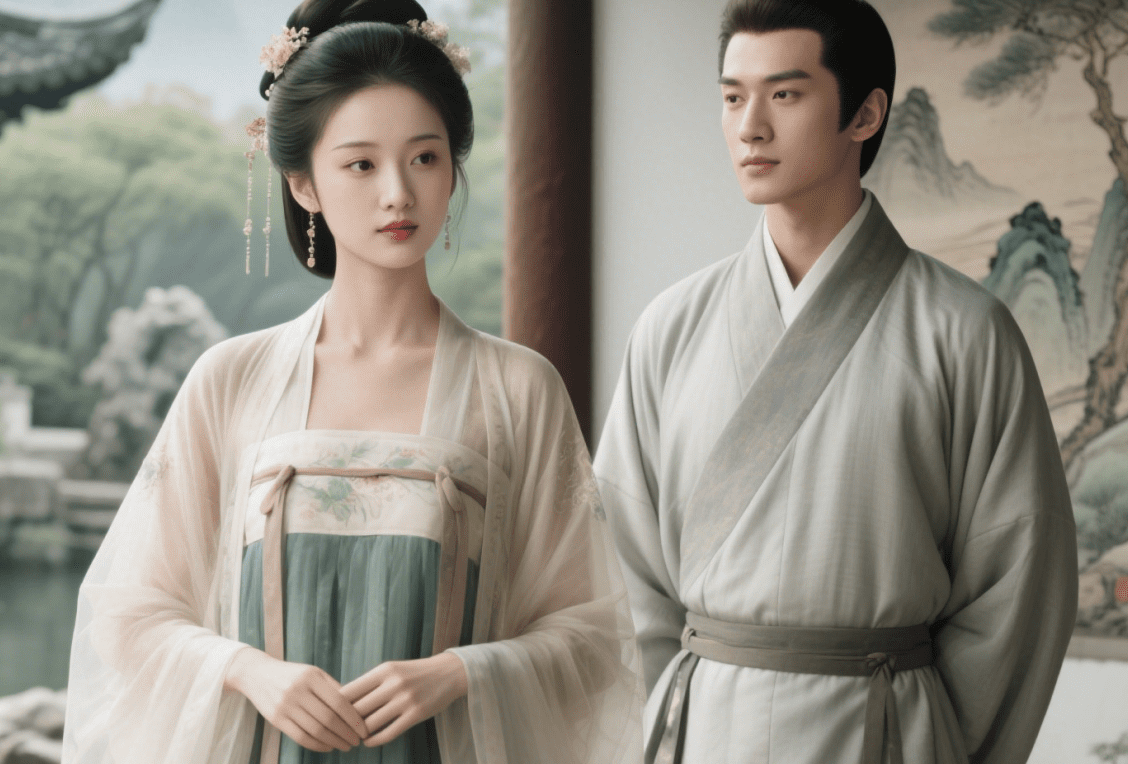The Beauty of Hanfu – Harmony of Yin and Yang
In the five-thousand-year history of Chinese civilization, Hanfu is not merely clothing but a flowing historical scroll. When we discuss Hanfu, images of women in flowing skirts often come to mind first, while the profound cultural heritage of men’s Hanfu is frequently overlooked. In fact, the differences between men’s and women’s Hanfu precisely embody the philosophical concept of “harmony between yin and yang” in traditional Chinese culture.
Chapter 1: Structural Differences – Gender Aesthetics in Cut
Women’s Hanfu: Artistic Expression of Curves
The most distinctive feature of women’s Hanfu lies in its skillful modification of female body curves. Taking the iconic qixiong ruqun as an example, its high-waist design draws visual focus upward, while the wide skirt falls naturally to form an elegant A-line silhouette, showcasing feminine grace while maintaining proper modesty.
Analysis of typical women’s styles:
Quju shenyi: Popular in the Han Dynasty, featuring unique “continuous lapel and hooked edge” tailoring with spiral-patterned draping that flows like water in motion.
Duijin ruqun: A Song Dynasty classic with symmetrical front closure, often paired with pleated or mamian skirts to highlight refined femininity.
Bijia with mamian: A Ming Dynasty combination where the sleeveless bijia complements the structured pleats of the mamian skirt, showcasing precision within rigor.
Men’s Hanfu: Sartorial Interpretation of Rectitude
Unlike women’s emphasis on fluidity, men’s Hanfu prioritizes squared, straight-line aesthetics. The zhiluo, for instance, features straight-cut tailoring with only slight shaping under the arms, embodying the Confucian ideal of “proper attire.”
Analysis of typical men’s styles:
Zhuzi shenyi: Worn by Song Dynasty scholars, strictly following the “compass, square, plumb line, weight, and balance” principles, with twelve lower panels representing the months.
Tieli: Ming Dynasty official wear with pleated front and back for both mobility and dignity.
Yisan: Originating from the Yuan Dynasty, combining upper and lower garments with flared pleats below the waist for both elegance and practicality.
Table: Comparison of main men’s and women’s Hanfu styles
Chapter 2: Historical Evolution – Fashion in Dialogue with Era
Wei-Jin Style: First Convergence of Gender Fashion
The Wei-Jin period marked a special chapter in Chinese fashion history. Social upheaval spurred intellectual liberation and sartorial innovation, witnessing fascinating gender convergence:
- Men adopted wide robes and even wore powder and perfume
- Women’s clothing incorporated cross-collar styles typically male
- Shared appreciation for “floating like clouds, dynamic as dragons” aesthetics
These changes reflected contemporary rethinking of gender roles.
High Tang Splendor: Gendered Fashion in Full Bloom
Tang Dynasty’s economic and cultural zenith birthed unprecedented sartorial diversity:
Women’s characteristics:
Bold styles like exposed necklines and half-sleeves
Functional-yet-elegant headwear like weimao and mili
Vibrant colors and patterns incorporating Central Asian motifs
Men’s characteristics:
Round-collar robes became official standard
Leather accessories denoting rank
Diversified futou headwear styles
Notably, women wearing men’s clothing became fashionable, as with Princess Taiping’s cross-dressing, reflecting social openness.
Ming-Qing Formality: Ritualized Gender Division
With Neo-Confucianism’s rise, gender differentiation intensified:
Women’s wear: Higher necklines, tighter sleeves, growing conservatism
Men’s wear: Strict official ranking system with buzi insignia
Shared excellence: Peak craftsmanship in embroidery and kesi tapestry
These changes mirrored late feudal society’s rigid gender norms.
Chapter 3: Detail Codes – Cultural Meanings in Accessories
Women’s Accessory System
Headwear:
Ji: Symbol of coming-of-age capping ceremony
Buyao: Shaking with movement, embodying kinetic beauty
Huasheng: Noblewomen’s headdress denoting status
Waist ornaments
Jinbu: Ritual accessory moderating deportment
Scent bags: Practical and decorative
Footwear:
Bound-foot shoes: Product of footbinding
Cloud-toe shoes: Elegant upturned design
Men’s Accessory System
Headwear:
Guan: Central to coming-of-age ceremonies
Jin: Symbol of scholarly refinement
Futou: Evolution from soft to stiff styles
Jade belts: Markers of official rank
Fish pouches: Official credentials
Court boots: Official standard
Cloud shoes: Hermit’s preference
These accessories embodied social status and personal cultivation.
Chapter 3: Modern Revival – Tradition Meets Innovation
Contemporary Women’s Hanfu Trends
Daily wear:
Modernized qixiong ruqun with contemporary accessories
Fusion of embroidery and minimalist design
Style diversification:
Xianxia: Layered gauze for ethereal beauty
Retro: Historically accurate reproductions
Guochao: Traditional motifs with modern cuts
Contemporary Men’s Hanfu Innovations
Cut modifications:
Tailored daopao for modern aesthetics
3D patterning for comfort
Material innovations:
Blended fabrics addressing wrinkling
Functional materials for various climates
Styling revolutions:
Hanfu-suit hybrids
Traditional patterns meeting streetwear
Chapter 4: Practical Guide – Choosing Your Hanfu
Women’s Selection Advice
Body type considerations:
Petite: Duijin ruqun to elongate proportions
Curvy: Tang qixiong for flattering drape
Occasion matching:
Daily: Song beizi with baidie skirt
Formal: Ming long ao with mamian
Weddings: Traditional phoenix coronet and xiapei
Men’s Styling Tips
Style positioning:
Scholar: Zhiduo with Dongpo jin
Military: Yisan with leather belt
Official: Daopao with black gauze cap
Seasonal adaptation:
Summer: Sheer tieli for breathability
Winter: Cotton-padded zhiluo for warmth
Hanfu’s Infinite Future Possibilities
In this millennial fashion dialogue, we see Hanfu’s gender differences as both historical products and cultural crystallization. In today’s revival movement, while men’s and women’s development paths differ, they share the same goal – revitalizing traditional attire.
As social concepts progress, Hanfu’s gender boundaries may further blur, yielding more boundary-breaking designs. Yet regardless of changes, the cultural DNA woven into every stitch will remain our treasured legacy.
https://tangpura.com/ Hanfu enthusiasts, come to our forum to discuss!

